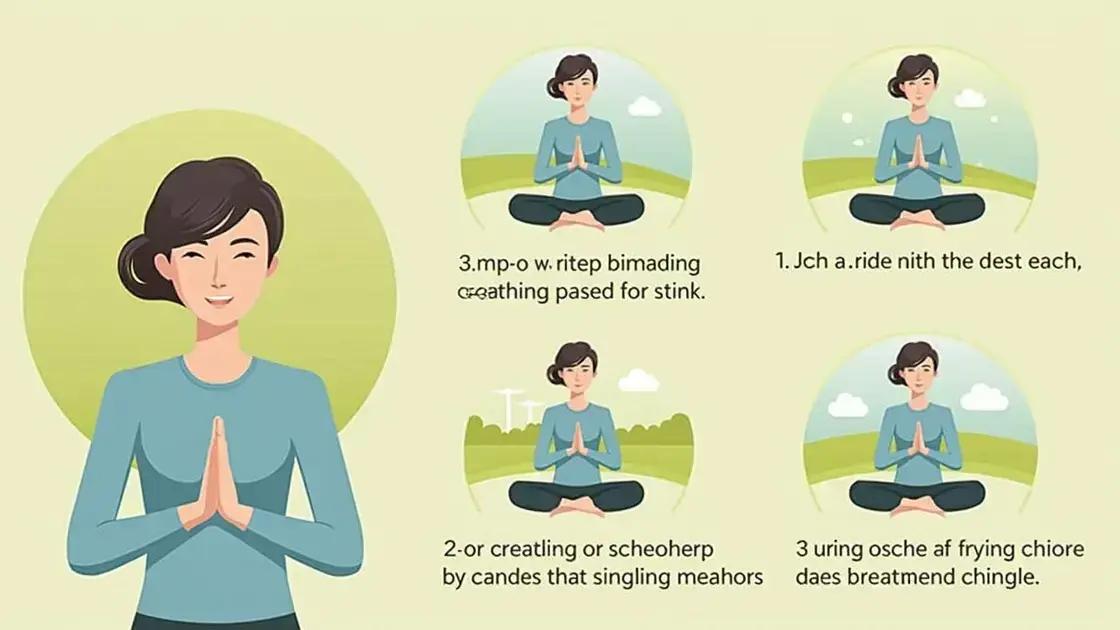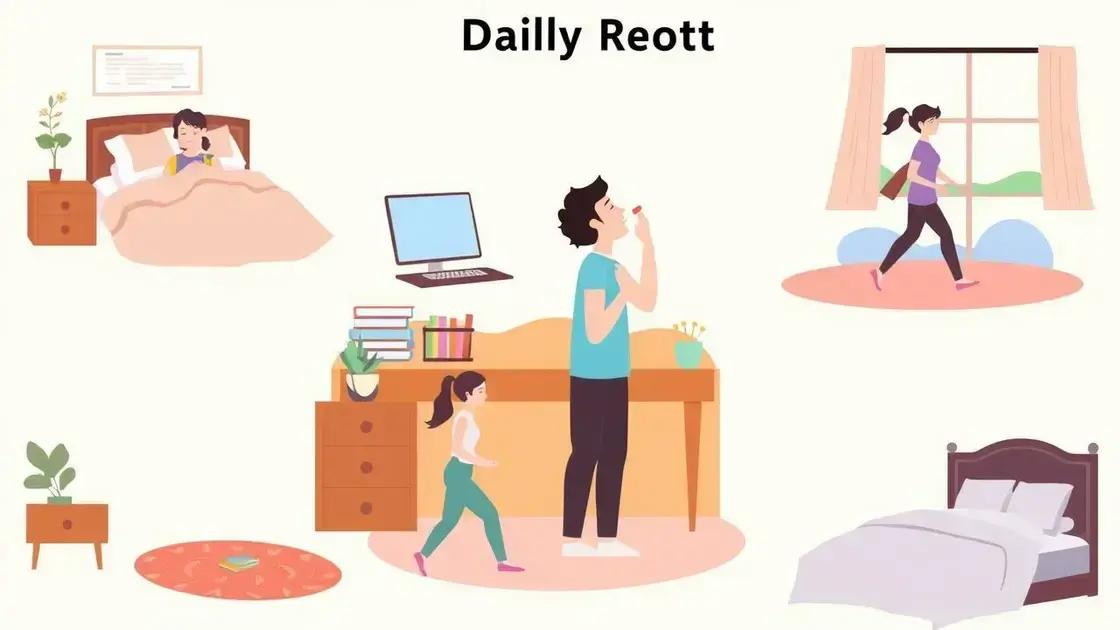The benefits of practicing deep breathing for relaxation include reducing stress, improving focus and emotional well-being, and enhancing physical health. Techniques like diaphragmatic breathing, 4-7-8 breathing, and box breathing can easily be incorporated into daily life for increased calmness and mental clarity.
Deep breathing is a simple yet effective technique for relaxation and stress reduction. By intentionally focusing on your breath, you can activate your body’s natural relaxation response. This method not only helps calm the mind but also offers numerous health benefits. In this article, we will explore what deep breathing is, its top benefits for stress relief, techniques to practice, and how to incorporate it into your daily routine.
What is Deep Breathing?

Deep breathing involves consciously controlling your breath to enhance relaxation and improve overall well-being. It is a practice rooted in ancient traditions and is used in various cultures worldwide. By focusing on your breath, you can calm your thoughts and bring your body into a state of balance.
When you breathe deeply, you take in more oxygen, which is vital for your body’s functions. Deep breathing activates the parasympathetic nervous system, promoting relaxation. Unlike shallow breathing, which can lead to feelings of anxiety and stress, deep breathing encourages the body to release tension and promote a sense of calm.
How Deep Breathing Works
During deep breathing, you engage the diaphragm, a muscle located at the base of the lungs. This allows your lungs to expand fully, drawing in more air. When you exhale slowly, your body clears out carbon dioxide. This process not only helps in delivering oxygen to your bloodstream but also lowers your heart rate and reduces stress hormones.
Practicing deep breathing regularly can contribute to better physical health, emotional stability, and mental clarity. It is an accessible technique that you can use anywhere, anytime, making it an ideal tool for relaxation.
Top Benefits for Stress Relief

Practicing deep breathing offers many powerful benefits that can significantly alleviate stress. One of the primary advantages is the immediate calming effect it has on the mind and body. When you take slow, deep breaths, you signal to your brain to reduce the stress response. This physiological change can help lower anxiety levels and promote feelings of relaxation.
Another benefit is improved focus and mental clarity. As stress decreases, your ability to concentrate improves. Deep breathing increases oxygen flow to the brain, which can enhance your cognitive functions and help you think more clearly.
Enhanced Mood and Emotional Well-Being
Engaging in deep breathing exercises can lead to an enhancement in mood. By activating the body’s relaxation response, you may experience less irritability and a greater sense of calm. This can also lead to better emotional regulation, making it easier to handle everyday stressors.
Physical Health Benefits
Deep breathing can improve physical health markers as well. Regular practice helps reduce blood pressure and promotes heart health. By lowering heart rates and alleviating tension, deep breathing contributes to overall physical well-being. Studies suggest that practicing deep breathing can boost the immune system, protecting the body against illness.
Incorporating deep breathing into your daily routine isn’t just helpful for reducing stress; it can provide lasting benefits that enhance both mental and physical health. By committing to this simple practice, you can unlock a richer, more balanced life.
Techniques to Practice Deep Breathing

Practicing deep breathing is an effective way to enhance relaxation and reduce stress. Here are some simple techniques you can try:
1. Diaphragmatic Breathing
Diaphragmatic breathing, also known as abdominal breathing, uses the diaphragm effectively. To practice this technique:
- Lie down or sit comfortably.
- Place one hand on your chest and the other on your abdomen.
- Breathe in slowly through your nose, ensuring your abdomen rises while your chest remains still.
- Exhale slowly through your mouth, letting your abdomen fall.
Repeat this for several minutes, focusing on the rise and fall of your abdomen.
2. 4-7-8 Breathing
This technique helps you control your breathing and is excellent for relaxation.
- Breathe in quietly through your nose for a count of 4.
- Hold your breath for a count of 7.
- Exhale completely through your mouth for a count of 8.
Repeat this cycle for at least four breaths. This method can help to calm your mind and reduce anxiety.
3. Box Breathing
Box breathing is a technique often used by athletes and military personnel to maintain focus and calmness. Here’s how to do it:
- Breathe in for a count of 4.
- Hold your breath for a count of 4.
- Exhale for a count of 4.
- Wait for a count of 4 before inhaling again.
This technique can be particularly effective before stressful situations, like public speaking or exams.
4. Guided Visualization
Guided visualization combines deep breathing with mental imagery. To practice this:
- Find a quiet place and sit comfortably.
- Close your eyes and take a few deep breaths.
- Imagine a peaceful scene, like a beach or forest.
- As you breathe, visualize all the details of this scene, engaging your senses.
This technique not only promotes relaxation but also helps improve your mental well-being.
Incorporating Deep Breathing into Daily Life

Incorporating deep breathing into your daily life can be simple and effective. Here are some ways to make it a regular part of your routine:
1. Start Your Day with Deep Breathing
As you wake up, take a few minutes to practice deep breathing. Before getting out of bed, sit up straight and take 5-10 deep breaths. Focus on filling your lungs fully and exhaling slowly. This sets a peaceful tone for the day ahead.
2. Create Breathing Breaks
Schedule short breaks throughout your day to practice deep breathing. Set a timer for 5 minutes every hour. During this time, step away from your work and focus solely on your breath. This can help reduce stress and improve focus.
3. Combine Deep Breathing with Other Activities
You can also incorporate deep breathing into activities you already do, like:
- Walking: As you walk, breathe deeply in sync with your steps. This can enhance relaxation and energize your body.
- Yoga or Stretching: Pair deep breathing with yoga poses or stretching. This will deepen the effects of both practices.
4. Use Reminders
Place sticky notes around your house or workspace that remind you to breathe deeply. It could be a simple note saying, “Take a deep breath!” These visual cues can help you remember to practice when you feel stressed.
5. Wind Down at Night
Before bed, take a few minutes for deep breathing. This can help calm your mind and prepare your body for restful sleep. Find a comfortable position, close your eyes, and breathe deeply as you let go of the day’s worries.
By integrating deep breathing into your daily routine, you can enjoy increased relaxation and enhance your overall well-being.
In Conclusion: The Power of Deep Breathing for Relaxation
Practicing deep breathing offers a multitude of benefits that enhance mental and physical well-being. By understanding what deep breathing is and utilizing various techniques, anyone can easily incorporate this practice into their daily routine.
From stress relief to improved focus and emotional balance, deep breathing can change your approach to everyday challenges. Establishing a habit of deep breathing not only helps manage stress but also promotes a healthier lifestyle.
So take a moment today to focus on your breath, embrace relaxation, and unlock the transformative power of deep breathing in your life.
FAQ – Frequently Asked Questions about Deep Breathing for Relaxation
What is deep breathing?
Deep breathing is a technique that involves consciously inhaling and exhaling to promote relaxation and reduce stress.
How can deep breathing help with stress relief?
Deep breathing activates the body’s natural relaxation response, helps lower heart rates, and reduces stress hormones, leading to a sense of calm.
What are some techniques for practicing deep breathing?
Some effective techniques include diaphragmatic breathing, 4-7-8 breathing, box breathing, and guided visualization.
How can I incorporate deep breathing into my daily life?
You can start your day with deep breathing, take scheduled breaks, combine it with activities like walking or yoga, and practice before bed.
Can deep breathing improve my focus?
Yes, deep breathing increases oxygen flow to the brain, which can enhance concentration and clarity.
Is deep breathing suitable for everyone?
Generally, deep breathing is safe for most people. However, individuals with certain respiratory conditions should consult a healthcare provider before starting any new practice.












